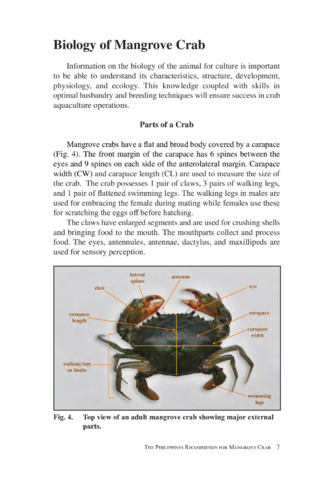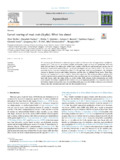Perlihatkan publikasi sederhana
Development of hatchery techniques for the mud crab Scylla serrata (Forskål): Comparison of feeding schemes
| dc.contributor.author | Quinitio, Emilia T. | |
| dc.contributor.author | Parado-Estepa, Fe | |
| dc.contributor.author | Alava, Veronica | |
| dc.contributor.editor | Keenan, Clive P. | |
| dc.contributor.editor | Blackshaw, Alan | |
| dc.date.accessioned | 2011-06-22T09:35:46Z | |
| dc.date.available | 2011-06-22T09:35:46Z | |
| dc.date.issued | 1999 | |
| dc.identifier.citation | Quinitio, E. T., Parado-Estepa, F., & Alava, V. (1999). Development of hatchery techniques for the mud crab Scylla serrata (Forskål): Comparison of feeding schemes. In C. P. Keenan & A. Blackshaw (Eds.), Mud Crab Aquaculture and Biology. Proceedings of an international scientific forum held in Darwin, Australia, 21–24 April 1997 (pp. 125-130). Canberra: Australian Centre for International Agricultural Research. | en |
| dc.identifier.uri | http://hdl.handle.net/10862/429 | |
| dc.description.abstract | Scylla serrata larvae were reared in 3 L plastic containers and fed various amounts of artificial diets (AD) with or without natural food (NF: Brachionus rotundiformis and newly-hatched Artemia). The amounts of AD fed alone to zoea in treatments (T) 1 to 4 were as follows: 1) 2.0 mg/L/day + 0.25 mg/L/day increment/substage; 2) 2.0 mg/L/day + 0.5 mg/L/day increment/ substage; 3) 4.0 mg/L/day + 0.5 mg/L/day increment/substage; 4) 4.0 mg/L/day + 1.0 mg/L/day increment/ substage. NF were given in addition to the respective amounts of artificial diet in T5, T6, T7 and T8. T9 served as the control (NF only). Based on three experimental runs, only larvae in T5, T6, and T9 survived until the megalopa stage. Thus, only these three treatments were compared in succeeding experiments using a commercial shrimp diet in 250 L fibreglass tanks. Of the three runs conducted using a commercial diet, two runs showed significant differences (P<0.05) in survival. T5 gave higher survival (3.71% and 1.33%) than T9 (1.84% and 0.45%) and T6 (1.37% and 0.45%). Population development index did not differ among treatments in three runs. | en |
| dc.description.sponsorship | This research was funded by ACIAR under research grant PN9217. | en |
| dc.language.iso | en | en |
| dc.publisher | Australian Centre for International Agricultural Research | en |
| dc.subject | Crustacea | en |
| dc.subject | Larval rearing | en |
| dc.subject | hatcheries | en |
| dc.subject | Philippines | en |
| dc.subject | crabs | en |
| dc.subject | Mud crab | en |
| dc.subject | Scylla serrata | en |
| dc.subject.lcc | VF SP 233 | |
| dc.title | Development of hatchery techniques for the mud crab Scylla serrata (Forskål): Comparison of feeding schemes | en |
| dc.type | Conference paper | en |
| dc.citation.spage | 125 | |
| dc.citation.epage | 130 | |
| dc.citation.conferenceTitle | Mud Crab Aquaculture and Biology. Proceedings of an international scientific forum held in Darwin, Australia, 21–24 April 1997 | en |
| dc.subject.asfa | feeding | en |
| dc.subject.asfa | aquaculture techniques | en |
| dc.subject.scientificName | Scylla serrata | en |
Files in this item
| Files | Size | Format | View |
|---|---|---|---|
|
There are no files associated with this item. |
|||
Publikasi ini ada di koleksi berikut
-
Conference Proceedings [299]




